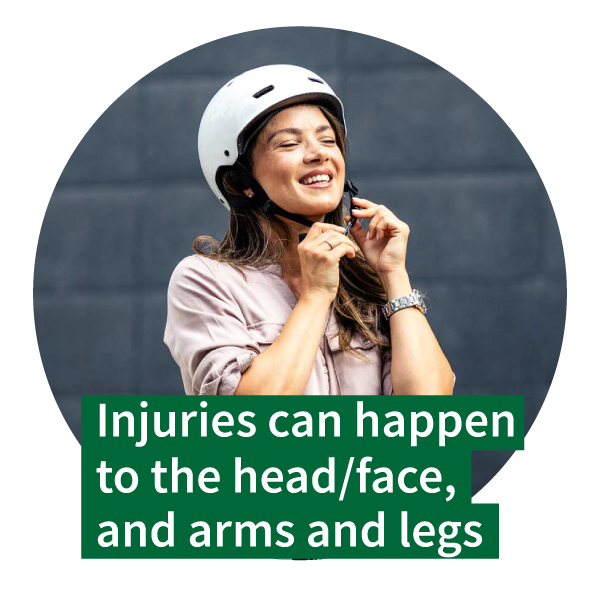Attention
We are currently updating our website. Please excuse any inconsistencies in our content or temporary disruptions during this time. Thank you.
We are currently updating our website. Please excuse any inconsistencies in our content or temporary disruptions during this time. Thank you.
Electric kick scooters (e-scooters) are a fun and convenient form of micromobility. They are growing increasingly popular all around the world, and are a sustainable form of transportation. E-scooter riders are considered vulnerable road users, and there are steps that both riders and motor vehicle occupants can take to reduce the risk of injury.
In 2021, the province of British Columbia (BC) piloted the use of e-scooters in participating communities. Although a licence is not required, there are some restrictions on who can ride an e-scooter and where.1
These restrictions include the following:
Participating municipalities are allowed to set their own rules (e.g., whether they allow the use of shared e-scooters).
BC follows national standards for health data reporting, and the option to code e-scooter-related injuries was introduced in 2022. New codes are updated every three years. Broadly, only hospitalization data are available, and they only capture falls from e-scooters. A coding guideline was made effective in early 2025 to include e-scooter incidents involving others, including bikes, pedestrians, and motor vehicles, but adopting new procedures takes time to train and implement across all hospitals. This results in a minimum one-year lag for accessing data. Some trauma units are collecting data but these are the most severe cases. Reporting on data at this time would be likely be an underrepresentation of the total number of injuries.

When riding an e-scooter, common areas of the body that can be injured include the head/face, and arms and legs. Causes of injury include falls, speeding, distraction, riding under the influence of drugs and/or alcohol, and not following the rules of the road.
BCIRPU is working to provide the Ministry of Transportation and Transit (MoTT) with BC Children’s Hospital data related to e-scooters on an annual basis from now until 2028. The first year of data (cases from April 1, 2024-March 30, 2025) were provided to MoTT in May 2025, and included the following variables: date and time of injury, sex, location, area, place, postal code, nature of injury, body part affected, safety equipment, and disposition. Learn more about this project on the BC Government website.
1 BCIRPU. (July 31, 2023). YouTube. A safe system for e-scooters: The potential for injury prevention with a new form of micro-mobility. https://www.youtube.com/watch?v=cKCsAX1LgfU
2 Government of BC. (September 22, 2025). Electric kick scooter rules and safety. Available from https://www2.gov.bc.ca/gov/content/transportation/driving-and-cycling/cycling/electric-kick-scooter-rules
3 ICBC. (2025). Electric kick scooters and motorized skateboards. Available from https://www.icbc.com/vehicle-registration/specialty-vehicles/Low-powered-vehicles/Motorized-scooters-and-skateboards
4 ICBC (2025). Quick Statistics – Crashing Involving Pedestrians. 5-year average 2020-2024. Available from https://public.tableau.com/app/profile/icbc/viz/QuickStatistics-Crashesinvolving/CrashesInvolving
5 Robertson, R.D., et al. Traffic Injury Research Foundation. (July 2025). Micromobility in Canada: Risks, Regulations, Knowledge Gaps & Opportunities. Available from https://tirf.ca/projects/micromobility-canada/

The BC Injury Research and Prevention Unit is a leader in the production and transfer of injury prevention knowledge and the integration of evidence-based injury prevention practices in the daily lives of those at risk, those who care for them, and those with a mandate for public health and safety in British Columbia.


